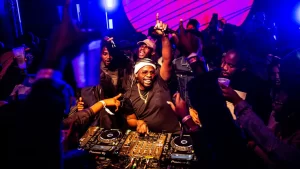Who Came With Amapiano
Who Came With Amapiano? In the covid year of July 2020, a sound documentary tagged Shaya was made public with the sole aim to determine the origin of amapiano music and its increasing popularity and acceptance as a genre. The 26-minute length work started with a line from Mark Khoza who is an event MC, artist, and associate of the popular king of amapiano music, Kabza De Small.
Who Came Up With Amapiano? The concept of the genre is that there would be someone who would play the keyboard along to a DJ’s set. During studio recordings, the keyboardist would play the piano over the scoring. As the sound goes on, the deep house would be infused in the process. Coincidentally, Kabza De Small played exactly as described. The genre was originally called NUMBER. Later on, the South African Singer MFR Souls came up with the name AMAPIANO and bloggers like Hiphopza, Zamusic and Fakaza2018 popularized it in the year 2017. In, actuality, those were the ones who started it.
Since its ever coming to the limelight in 2017, there has been a contentious drag as regards when the genre began and who set it in motion.
Amapiano is a fairly new genre of South African music. originally, when the kidney started gaining fashionability in 2017, amapiano was known for its fantastic (frequently twinkles long piano solos). ‘ unheroic, unheroic ’, a 2015 release by Calvin Fallo (one of the genre’s founding numbers) features a broken barrel beat anchored by close to six twinkles of piano riffing and screaming organs. It’s the kind of song that specifically lends itself to live performances. You can nearly imagine Fallo going up and down different octaves in the nothingness of the night while a crowd shouts “ shaya, i- number ” in his direction.
In discrepancy, recent amapiano releases have been marked by their restraint. The emotional import of a song like ‘ Amanikiniki ’(produced by the genre’s founding fathers, MFR Souls) is embedded in the call and response lyrics. Indeed ‘ Ndofaya ’, which featured on Kabza De Small’s debut reader, ‘ I Am The King of Amapiano ’ sounds more like kwaito than anything he made three times back.
Between 2017 and now, the genre’s fashionability has moved well past South Africa’s borders. From Boiler Room x Ballantine’s True Music shows to global stars picking up the sound, the kidney has blazed across the world
Leading this charge is DJ Maphorisa – an original statuette in the house scene. Before he settled on amapiano, the DJ boasted product credits similar as Drake’s One Dance, Major Lazer’s Particula (which features US artist Jidenna) while also producing for international titans Wizkid and Mafikizolo).
In 2020, Kabza De Small (who is inked to Maphorisa) released Sponono – a song which features Wizkid and Burna Boy. It’s not beyond the realm of possibility that Maphorisa used his international muscle to have the two Nigerian artists (who boast a large transnational followership) onto the song. also, original amapiano artist and recent ‘ True Music In Round South Africa ‘ star, Focalistic( whose music straddles the line between amapiano and rap), enlisted Davido for the remix of his 2020 megahit, Ke Star.
But one of the genre’s biggest transnational nods came in mid-2020 when Zimbabwean-born artist Sha Sha (frequently appertained to as ‘ the queen of amapiano) bagged a BET award for the stylish transnational act. Her sound, which can be distributed as equal corridor amapiano and smoked-out soul, differs from Kamo Mphela( another seminal womanish figure in the genre). Nkulunkulu, a song by Mphela, is embedded in the genres before the tradition of call-and-response lyrics. Featuring window-rattling log cans and subtle piano warbles have gained over a million views since dropping on 26 March.
Who Started Amapiano? Khuza Gogo ’, a song by womanish house DJ DBN Gogo (who later featured in the ‘ Ballantine’s Stay True metropolises South Africa series) has been an endless institution on original radio stations since its release, spawning colourful TikTok challenges.
These three artists( with styles that sit on contrary ends of the stripes poles) represent the womanish musicians leading the charge to increase the genre’s fashionability. Unlike house music where womanish voices can frequently have their benefactions understated or canceled — women are correctly viewed as the bedrock of amapiano.
Woza, a recent release by popular amapiano patron Mr JazziQ, is held together by the oral benefactions of Lady Du. The same can be said of Junior De Rocka’s ‘ Catalia ’. Indeed ‘iDlozi Lami’ by DJ Obza( a recent megahit) is reduced to background music without the oral donation of Nkosazana.
In some manner, amapiano shares the same story as gqom. The blend-and-match structure that illustrated gqom’s early releases isn’t different from that used by forthcoming amapiano directors. Both stripes carry a heavy DIY morality. Music is produced, distributed via Whatsapp groups, bootlegged CDs and premiered in clubs. Popular Whatsapp groups similar to Amapiano World, Amapiano Music, and Amapiano Fan Base serve as quick, affordable distribution capitals to debut music from directors looking to spread their music across the length and breadth of the country. Also, without the hindrance of major markers, and A&R s demands to pantomimist the flavour of the month, artists are free to test new ideas as and when they please.
While gqom had its moment( at its peak, the genre was the subject of transnational seductiveness), the fifteen twinkles eventually ran up and the genre now enjoys a parochial fashionability in Kwazulu Natal(its motherland).
Whether the same will be true of amapiano remains to be seen.
Ballantine’s has long been supporting South Africa’s vibrant music scene, from Amapiano to Gqom to Deep House. Since 2015 it has taken us across the country, hosting shows in Johannesburg, Durban, Cape Town and Pretoria. So snare a glass and catch all the sets back and be sure to follow our True Music Playlist as we celebrate music from SA and beyond!

